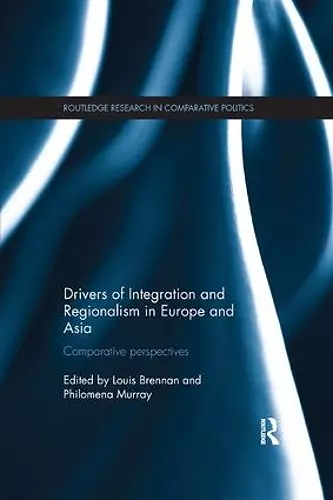Drivers of Integration and Regionalism in Europe and Asia
Comparative perspectives
Louis Brennan editor Philomena Murray editor
Format:Paperback
Publisher:Taylor & Francis Ltd
Published:7th Feb '17
Currently unavailable, and unfortunately no date known when it will be back
This paperback is available in another edition too:
- Hardback£150.00(9781138819818)

This book examines the drivers of regionalism and integration in both Europe and Asia and seeks to forge comparative perspectives between the two regions.
Comprising contributions from scholars, analysts and policymakers, this volume explores and debates how and why regional bodies such as the European Union (EU) and the Association of Southeast Asian Nations (ASEAN) are formed and sustained. Furthermore, it examines the drivers of, and impediments to, regionalism and integration. The debates regarding what and who constitute drivers are presented in a fresh, thematic and comprehensive manner. Leadership and core states are also critically examined, whilst material, ideational and normative factors are all assessed comparatively. Significantly, in light of the global financial crisis, the book considers the role of crisis as a driver of regionalism and integration.
This book will be of interest to students, scholars and policymakers interested in Asian and European politics and comparative politics.
This is a scholarly, comprehensive and timely study of the different experiences of regional integration that Europe and Asia, two of the world’s most diverse and important areas, have had in recent history. Covering issues like trust, sovereignty, reconciliation and values, the contributors show that in spite of differences, there is much that both can learn from each other as they strive for a more dynamic relationship in the 21st century.
Kerry Brown, Director of the China Studies Centre and Professor of Chinese Politics, the University of Sydney.
The book offers rich insights into the drivers and development of regionalism in Europe and Asia, covering a wide range of themes and providing comparative perspectives between the two regions. Its worthy analysis represents an invaluable guide and a must-read for all who are interested in regional studies.
Emil Kirchner, Jean Monnet Chair, University of Essex.
This is an excellent book that fills a much needed gap in the literature on regional integration by analysing the comparative drivers of regional cooperation in Europe and Asia. What is especially welcome in this volume is a comparative approach that does not take European regional integration as a benchmark for Asian regional integration. It sets out an exciting agenda for future work on comparative regionalism which will be invaluable for researches working on regional governance. Highly recommended.
Kanishka Jayasuriya, Professor of Politics and International studies and Director of the Indo-Pacific Governance Research Centre at the University of Adelaide.
Detailed yet highly accessible, a cutting-edge account of the key driving forces behind regional integration in Europe and Asia. Carefully avoiding a Eurocentric approach, the contributing authors provide scholars and policymakers alike with an essential source of conceptual, empirical, comparative and multidisciplinary insights into the study of regions.
Bart Gaens, Senior Research Fellow, The Finnish Institute of International Affairs.
The European Union (EU) and the Association of Southeast Asian Nations (ASEAN) are two relatively successful regional organizations in the world, and their trans-regional cooperation in the Asia-Europe Meeting (ASEM) is likely to redefine and affect both regional and global politics. In this context, there is an increasing demand for knowledge in order to understand both regional organizations and their collaborative relations and efforts. This edited book meets this demand by undertaking a comprehensive comparative study of European and Asian regionalism. The intellectual virtue of this book lies in the fact that it brings together diverse scholars from both regions and offers a variety of fresh perspectives. The uniqueness of this book is its focus on the multifaceted drivers of, as well as impediments to, regionalism in comparative terms. It covers a wide range of issues such as the role of crisis, traditional and non-traditional security, economic dynamics, regional institutions, and processes of European and Asian regional integration. I strongly recommend it as a textbook for graduate courses on international relations, comparative regionalism, and global politics.
Professor Baogang HE, Nanyang Technological University, Singapore.
This volume is an important contribution to the quickly expanding field of research on Comparative Regionalism. In this comprehensive text, a broad range of potential driving forces of integration in Europe and Asia are being explored, from historical narratives and institutional dynamics to the influence of economic crises and sector-specific interests. Brennan and Murray have assembled a group of leading experts who leave no stone unturned in identifying the drivers and barriers to regionalism on the two continents.
Thomas Christiansen, Professor of European Institutional Politics, Maastricht University
ISBN: 9781138714519
Dimensions: unknown
Weight: 453g
432 pages